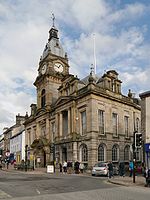Church of Holy Trinity and St George, Kendal
19th-century Roman Catholic church buildings in the United KingdomEngvarB from August 2013George Webster church buildingsGothic Revival architecture in CumbriaGothic Revival church buildings in England ... and 4 more
Grade II* listed buildings in KendalGrade II* listed churches in CumbriaRoman Catholic Diocese of LancasterRoman Catholic churches in Cumbria

The Church of Holy Trinity and St George is in New Road, Kendal, Cumbria, England. It is an active Roman Catholic parish church in the diocese of Lancaster. It is recorded in the National Heritage List for England as a designated Grade II* listed building. The church was founded by the parish priest, Thomas Wilkinson, and designed by local architect George Webster. Architectural historians regard the church as the best of the three designed by Webster in the town.
Excerpt from the Wikipedia article Church of Holy Trinity and St George, Kendal (License: CC BY-SA 3.0, Authors, Images).Church of Holy Trinity and St George, Kendal
Blackhall Road,
Geographical coordinates (GPS) Address Website External links Nearby Places Show on map
Geographical coordinates (GPS)
| Latitude | Longitude |
|---|---|
| N 54.328 ° | E -2.7435 ° |
Address
Holy Trinity and St George
Blackhall Road 33
LA9 4BW , Mintsfeet
England, United Kingdom
Open on Google Maps










